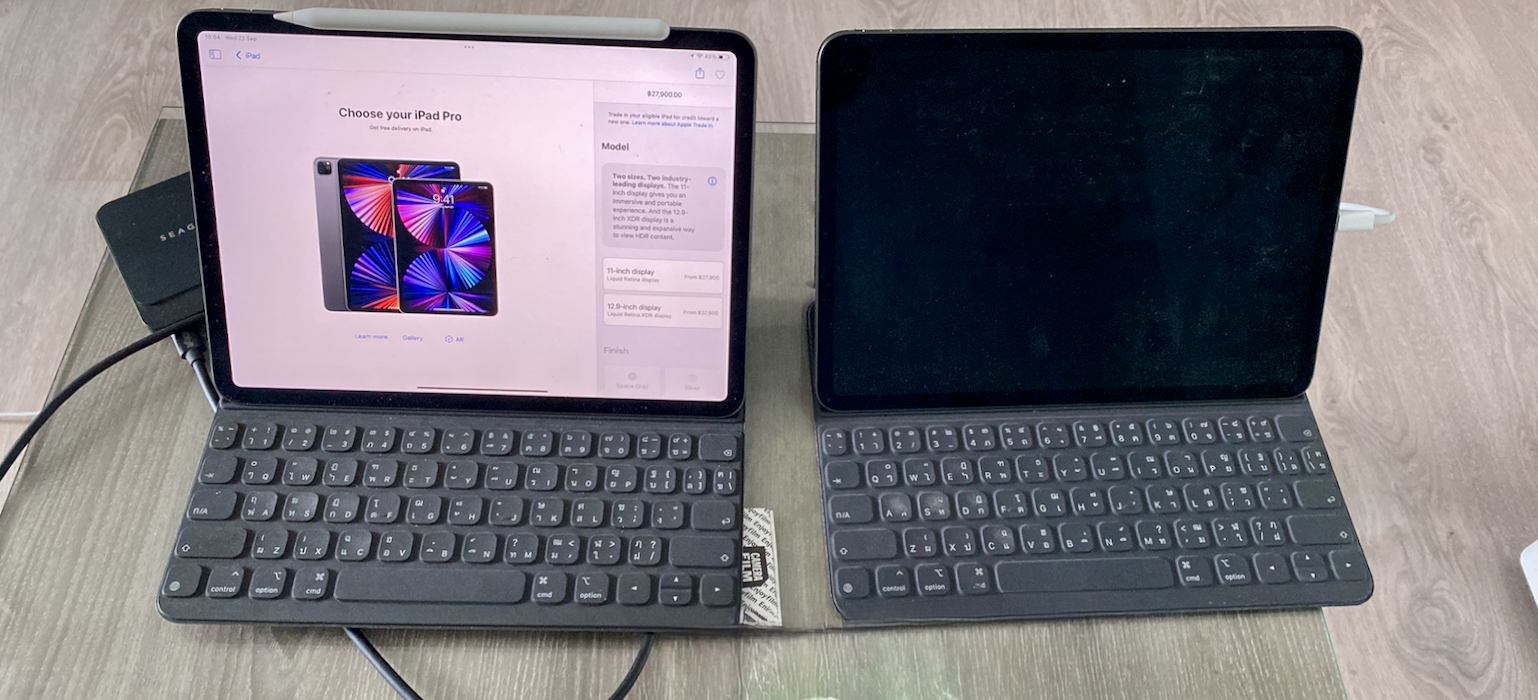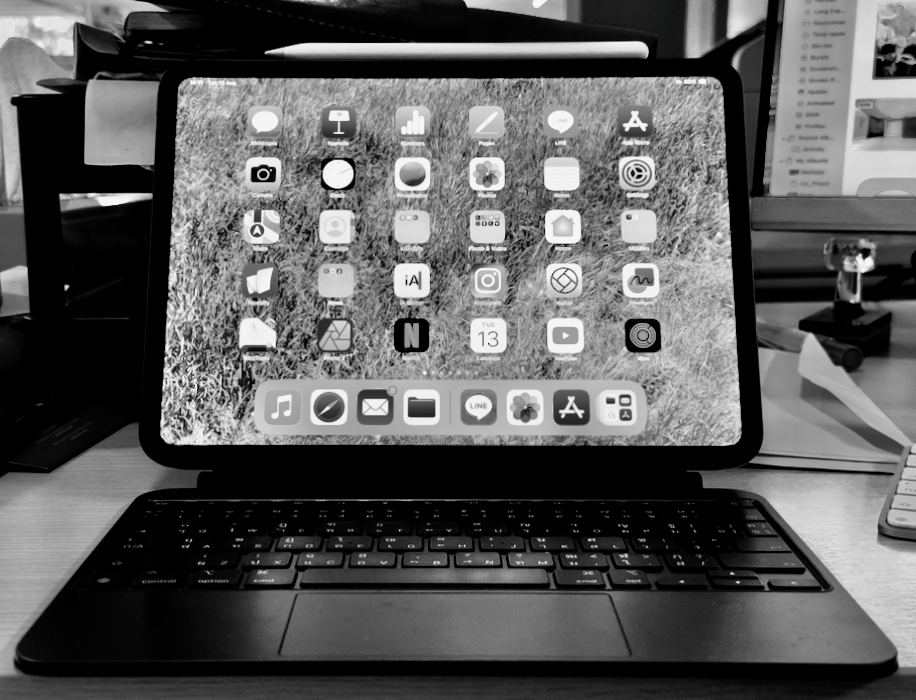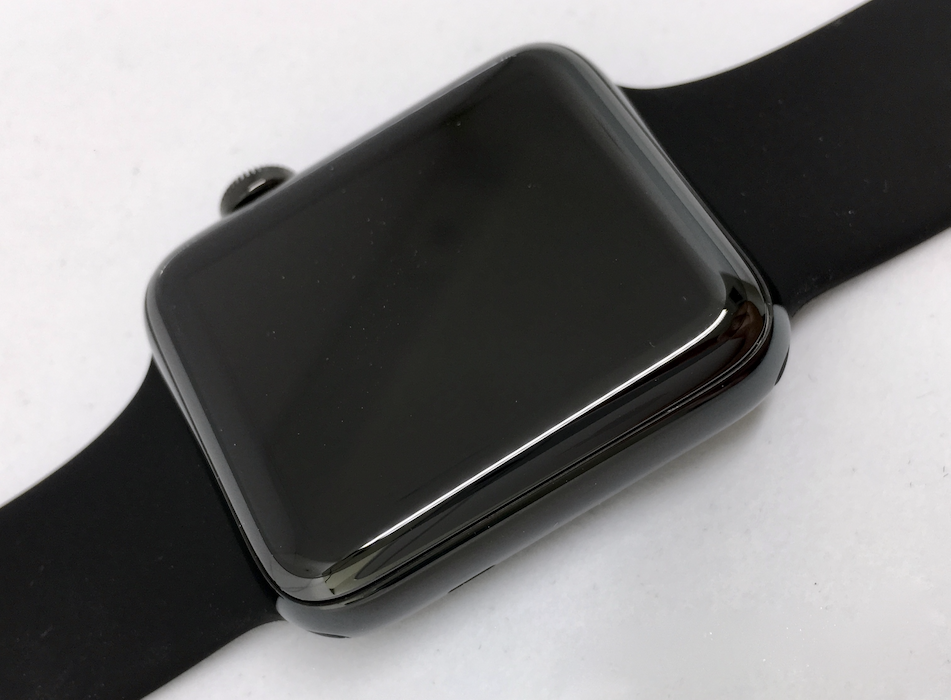
eXtensions - Monday 11 August 2025
By Graham K. Rogers

The iPad has gained quite a few tricks since it arrived, including (now) brain interfacing. With the economic bullying in the USA, it is no wonder that CEOs like Tim Cook will take questionable steps to smooth the path. With some time at home, I have been catching up on movies and TV series. I found another excellent German series this week on Netflix, while Apple has some good offerings in the pipeline.
When the iPad was first announced in 2010, it was pitched as being better than a netbook, with features that would improve email, web browsing and viewing videos. I have watched the presentation of that introduction several times, and use it in teaching, not only for the way that it is set out (history, background, current solutions, their problems, the new solution), but the timing. Give or take a second or so, the word, iPad, drops onto the screen at 9 minutes. As I point out to the students, you cannot do that without rehearsal. I am afraid the point is lost on most of them.

There were some comparisons between the iPad and the Kindle, with the inference that this would be a reading device. When the first ones became available, it was interesting to see that Apple had tapped into a new user group: some who did not want to use a computer, but were interested in such a communications device with a larger screen than a smartphone. Touch controls were another attraction. I thought that the involvement of News International and its Daily app - a newspaper online - would be a significant marker for what this device could do, but the publishers made several mistakes. Like other news outlets, they did not grasp the significance of the internet and treated it like paper-based media, on a glass screen.
Look at how newspapers have failed worldwide (and the 2013 documentary Black and White and Dead all Over for an early insight into such failures. News International also failed to appreciate the world-wide nature of the iPad (and similar devices) by making this app available only in the USA and Australia. From Bangkok I have access to news from several countries and use the different reporting slants to have a better understanding about events than my family in the UK. Indeed, I sometimes know more about what is going on in the UK than they do.

What made the iPhone so effective eventually, also applied to the iPad: the developers. Phil Schiller was on record as saying the way the iPad was used (education, research, medical, music) caught Apple by surprise. The Pad Pro, particularly, has become my go-to device for much of what I do: writing, photography, editing papers; while many of my students also use the iPad for note-taking and their engineering work, although I wish they would not rely on OCR (optical character recognition) to convert those notes into typed text. They miss a step in the processing that the brain does.
Recently, Johnny Evans (AppleInsider Must) reported on the way the iPad has been used to help a patient with ALS: Amyotrophic lateral sclerosis. This is sometimes called Lou Gehrig's disease. It affects nerve cells in the brain and spinal cord, causing loss of muscle control (Mayo Clinic). The patient uses a brain-computer interface (BCI) and has an implant developed by Synchron. Clearly a lot of work has gone on behind the scenes. The article by Evans links to a video that is also available on YouTube. This is well-worth watching. Christian Zibreg (iDownloadBlog) also reports on this development from Synchron.
The Faculty of Engineering at Mahidol University where I work had also done some research on brain interfacing. Instead of an implant, this used a cap, with contacts that connected with the scalp, so was using less powerful input signals compared to the Synchron implant.
Christian Zibreg (iDownloadBlog) also reports on a new development from Apple with regard to image sensors that could reach the same levels of dynamic range as the human eye. If this works out, it could replace the Sony sensors Apple currently uses. Coincidentally, a short time after this, it was announced that, perhaps as part of the readjustments following tariffs. Jeremy Gray (PetaPixel) reports that Apple has now moved its purchase of image sensor chips from Sony to Samsung who will make the chips in its Austin Tx facility.
A number of users have been concerned with the way Tim Cook has tried to cozy up to the current White House incumbent. Last week, Cook announced a new investment in the USA "plans to invest $100B in U.S. manufacturing efforts" (Marko Zivkovic, AppleInsider). At the same event it was revealed that Apple will be exempt from the 100% semiconductor tariffs that were announced at the same event. There is more on this and other investments in the press release from Apple.
Another adjustment was announced last week with the long time Corning relationship. All glass for the iPhone and Apple Watch is to be made in the Corning plant in Kentucky. Ian Carlos Campbell (Engadget) also reports on the Apple White House announcements and includes some useful supporting information. Articles from Juli Clover (MacRumors) and Malcolm Owen (AppleInsider) also provide more information on this investment move.

Mike Masnick (TechDirt) reports on the UK Online Safety Act which is unfortunately working exactly as had been predicted to the detriment of online users who are unable to access information they legitimately need. Masnick notes that there has been a significant expansion of VPN use (1800%) in the immediate period after the latest requirements of this odious law came into force. There is also criticism in some quarters concerning the UK law change that has meant the arrest of many protesters (some old and disabled) for holding up posters that the government does not like. It makes Britain, and particularly the Home Secretary, look foolish.
The power of 3. As another footnote to the recent Apple Q3 2025 figures, when we were told that 3 billion iPhones have now been sold, Ed Hardy (Cult of Mac) reports that the iPhone brings in 3 times the revenue of other phones: "a whopping 43% of the global smartphone total". He adds that this is from selling high-end models, while rivals revenue comes from basic smartphones." I guess there is no point in selling the most smartphones if the revenue is so low as to be almost invisible. Samsung leads the world in handset shipments with 20% of the market as opposed to Apple's 17%. However, all those phones only brought in 15% of the total revenue, while Apple's smaller market share received 43% of that world revenue.
 We should be expecting new versions of Apple's operating systems next month. These will contain several changes to apps and to the interfaces. One minor change with some significance is the hard disk icon on the Mac. For years this has been depicted by a high definition image of an old-style disk.
We should be expecting new versions of Apple's operating systems next month. These will contain several changes to apps and to the interfaces. One minor change with some significance is the hard disk icon on the Mac. For years this has been depicted by a high definition image of an old-style disk.
This image is so good that, if enlarged, the printing on the icon can be read. Of course, Apple has not used such hard disks for a few years and the Macs use solid state drives (SSD). To match this, the new icon will be a fairly bland SSD representation (Juli Clover, MacRumors).
I have already copied the current icon to a folder so I will be able to use that in the future. Highlight the disk and press Command + i (Information). The panel that opens shows an icon at the top. That can be copied (command + c). I created a new, empty folder, pressed command + v and pasted the disk icon into the new Information panel.
I have several unusual folders, including some with icons originally based on Andy Warhol art. There is also an app from Erica Sadun, Folderol, that allows you to change the color of a folder, but a feature that allows folder icon editing is apparently coming to macOS 26 when it is released

An older movie just appeared on Netflix and it has a long list of stars. I had not even heard of the 2008 Coen Brothers movie, Burn After Reading. This movie featured a list of stars including John Malkovich, George Clooney, Frances McDormand and Brad Pitt. By coincidence this weekend I also watched The Big Short in which Brad Pitt also appears.
I watched the first couple of episodes of Chief of War last week and made some comments on how different this was to other historical dramas, comparing it (in a minor way) to the the 2006 Mel Gibson movie, Apocalypto. There are some useful comments from David Snow (Cult of Mac), particularly on the historical accuracy the series makers have strived for. Like me, he also notes the use of the stunning scenery.

Apple has quite a lineup of new AppleTV series and movies Ryan Christoffel (9to5Mac) reports. Among these are Highest to Lowest (a Denzel Washington, Spike Lee movie); Season 4 of The Morning Show; Season 5 of Slow Horses; The Lost Bus movie with Matthew McConaughey; a new series with Emma Thompson, Down Cemetery Road (written by Mick Herron who also wrote Slow Horses); and other offerings. A new season of Invasion will be on the screens on 22 August.
I mentioned recently my enjoyment of the German series, Dogs of Berlin on Netflix, but I have enjoyed German (and other North European) series on Netflix before, most notably, Dark that ran for 3 series (2017-2020). Currently, I am watching a compelling limited 2023 series, Dear Child (or Liebes Kind), a police thriller with a difference. Recommended if you don't have an aversion to foreign language series and subtitles (I don't).
Graham K. Rogers teaches at the Faculty of Engineering, Mahidol University in Thailand. He wrote in the Bangkok Post, Database supplement on IT subjects. For the last seven years of Database he wrote a column on Apple and Macs. After 3 years writing a column in the Life supplement, he is now no longer associated with the Bangkok Post. He can be followed on X (@extensions_th). The RSS feed for the articles is http://www.extensions.in.th/ext_link.xml - copy and paste into your feed reader.

For further information, e-mail to
Back to
eXtensions
Back to
Home Page